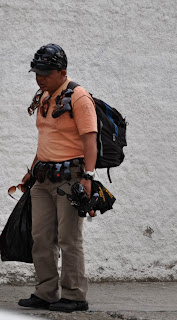Though we own a car and are quite comfortable driving now, it took some time to get used to all the idiosyncrasies of maneuvering through the city. Interestingly, a number of our friends, who originally didn’t have a car, have recently purchased one, mainly for trips out of town. We have found that the streets and roads are in good shape compared to other South American cities. The potholes are usually filled quickly after they appear. If you are a driver, you will find that the gas stations are manned with a half dozen eager attendants. There is no such thing as self service in Ecuador and the attention is quick and efficient. Gas is presently $1.48 for Extra and has been for at least a year or more, a low price compared to America and Europe and is primarily due to the nationalized petroleum cartel. You will also enjoy not having to pay that painful fifty cents for air to fill your tires as you do in the US. Air and water are free at all gas stations. In the Centro of Cuenca, SOAT, an arm of the city government that oversees licensing and ticketing, has agents roaming each street who will sell you up to an hour’s parking permit for a dollar which allows you to park in allowable spots on the street. If you cannot find a SOAT person after you park on the street, you can purchase a permit at almost any store near your parked car. You merely write in the time and date on the permit and put it on the dashboard for the roaming SOAT agent to see. Until we learned this system, we parked and, of course, got a ticket. It took two days of asking and driving around to suggested places before we found a rather obscure location where we could pay our $10 parking fine only to find out later that we were ripped off. It was not the correct place to pay. We recently found out that you can pay parking tickets at the caja at the motor vehicle compound just off Solanno near the main Banco Pichincha. There are very few painted lane markings on Cuenca’s streets and roads and it probably wouldn’t make any difference if there were as drivers often pay no attention to staying in a particular lane and weave in and out at will. It is a little disconcerting to see cars parked along a two way street facing in both directions on both sides of the street. Apparently this is not a parking offense. However, the city is making a commendable effort to crack down on violations but this appears to be an almost insurmountable task. Almost everyone walks everywhere in the city or takes a taxi for $2 or less so a car really isn’t necessary. Here is a photo of our tiny 4 passenger taxis.
We have always had a car and it was an addiction too hard to break. We feel that driving into the vehicle crowded Centro is not a problem once you are used to it. There are Parquedero’s or parking lots on almost every block where you can park your car for about 60 cents an hour. They give you a greater sense of safety for your car and anything left inside compared to leaving it on the street. Car radios sold in Ecuador have a pop off control panel that you would be wise to remove and take with you when you leave the car on the street. Having a car in Cuenca is a personal choice but we enjoy using it to drive up into the mountains and to visit the fascinating small towns and their market places. And, it is amazing how much we end up hauling around. One way or the other, we find ways or excuses to justify owning a car.
+Bill+and+Loretta.bmp)

+garbage+truck.bmp)











+bagged+juice.bmp)









+laborers.bmp)
+wood+gatherer.bmp)
+guards.bmp)

+Comida+Tipico.bmp)

+wealthy+family.bmp)

+Jonny+bus.bmp)



+Eucalyptus.bmp)




